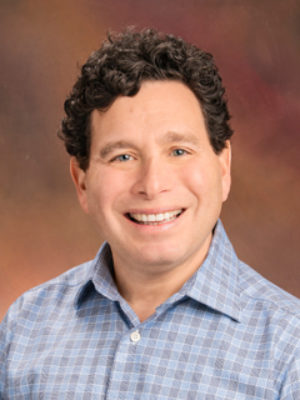Dr. Joel Fein: Taking a Trauma-Informed Approach Through Hospital-Based Violence Intervention Programs

11.3.2022
Safety in Numbers
Welcome to Everytown Research’s Safety in Numbers blog, where we invite leading experts in the growing field of gun violence prevention to present their innovative research in clear, user-friendly language. Our goal is to share the latest developments, answer important questions, and stimulate evidence-based conversations on a broad range of gun safety topics in a form that allows all of us to participate. If you have a topic you want to hear more about, please feel free to suggest it at: [email protected].
Sarah Burd-Sharps, Senior Director of Research
Note: The views, opinions, and content expressed in this product do not necessarily reflect the views, opinions, or policies of Everytown.
When Dr. Joel Fein began work as a trainee in the emergency department at Children’s Hospital of Philadelphia (CHOP), it became clear to him that there were larger social issues contributing to his patient’s medical issues. For one: gun violence. And it appeared to him that little was being done at the time to try to address this.
To fill this gap in the healthcare community, Dr. Fein began the Center for Violence Prevention (CVP) at CHOP where he currently serves as co-director. The center addresses bullying, intimate partner violence, peer youth violence, suicide, and gun safety. It uses a trauma-informed approach that addresses violence at various stages of childhood. Dr. Fein is also a pediatrician and emergency medicine physician at Children’s Hospital of Philadelphia, a Professor of Pediatrics at the Perelman School of Medicine at the University of Pennsylvania, and the research director for The Health Alliance for Violence Intervention (The HAVI). His research is inspired by his interactions with patients and their families. He tries to bring attention to or directly address the gaps in care for children experiencing violence, behavioral health problems, or both.
Learn more about Dr. Fein in his own words:
As I started out in the emergency department as a trainee and young faculty member, it became clear to me that many of the “medical” issues that we were treating were either caused by, made worse by, or made more difficult to manage by, the social forces in people’s lives. A few mentors at CHOP were already addressing larger issues such as, economic instability, access to healthy food and food insecurity, and housing safety even before these issues became commonly known as “social determinants of health.” I was fortunate to work at a pediatric institution with colleagues who valued prevention and understood that physical health is inextricably linked to family and neighborhood assets and support.
I realized that personal safety, or lack of it, can be a significant driver of psychological and emotional problems in kids. They cannot learn or play when they are worried about being hurt or killed on the way to the park or to and from school. Gun violence can be the most menacing and unpredictable threat. At the time I was doing my medical training, there was little happening to address this in the healthcare community. So it seemed natural to try to fill this gap.
Hospital-Based Violence Intervention Programs and Taking a Trauma-Informed Approach
One of the programs that I started at CHOP early on in my career was the Violence Intervention Program (VIP), an intensive “wraparound” experience for children ages 8 to 18 wounded by community violence. To alleviate the impact of these types of injuries, this hospital-based violence intervention program (HVIP) provides intensive case management to help families navigate complex city agencies and systems (e.g., education, legal) and also provides emotional support and connections to mental health care.
All of the work that is done through HVIP’s requires a trauma-informed approach, always taking into consideration how a person’s behaviors and reactions are influenced by their life experiences, including adverse childhood experiences. By joining the patient and family where they need us most and by buffering any perceived threat to their integrity, safety, or privacy, these programs can help to form stronger and more lasting bonds.
The VIP is among a collection of programmatic and research efforts undertaken by the Center for Violence Prevention at CHOP to address violence at multiple touchpoints at various stages of childhood. In addition to community violence, we also address intimate partner violence, bullying prevention in elementary and middle schools, gun safety and gun storage, and suicide prevention. We prioritize trauma-informed training when we hire team members and promote the notion that any care that is delivered—trauma-informed or otherwise—should be filtered through a lens of racial equity. We have developed educational efforts, both internal to the center and external throughout our institution, to help foster that approach.
Working with Community Partners
CHOP VIP staff interface with city agencies, local nonprofits, schools, and criminal justice and law enforcement departments. Our client’s needs guide our interactions with these agencies, and these can include mental health care, job training, educational advocacy for school transfers or individualized education plans (IEPs), finding affordable housing and utilities, and helping with food insecurity. The goal is to work alongside families so that they also build the confidence and capacity to interact with these agencies on their own.
Measuring Success
Our research helps us learn how our programs work and what could allow them to be more efficient and effective. We are currently completing a National Institutes of Health-funded study looking to prevent or reduce post-traumatic stress symptoms early on after a violent injury. Interestingly, our clinical team has begun to recommend this program for kids who are not necessarily eligible for the study, so we hope that is an indication of our program’s success.
In the 10 years that we have been in operation, we have many individual stories of CHOP VIP graduates who went on to succeed in school and life, some of whom used the experience to go on to work in family-serving systems. I am sure that similar stories can be told from the other HVIPs around the country. To be able to tell the full story, we need to expand our definitions of success to include quality of life, mental health, and educational and occupational goals, rather than simply a goal of avoiding reinjury, incarceration, and death.
There is a decade or more of research on these programs, mostly demonstrating better individual-level outcomes for clients of these programs rather than population-level ones. We have a wonderful organization called The HAVI which started as a national coalition of HVIPs and continues to elevate and amplify the work. A new HVIP program standard poster explains how HVIPs work and the research that supports them.
Gun Violence is a Public Health Crisis
Gun violence is so pervasive and damaging to neighborhoods and individuals that it takes an entire ecosystem to properly address the issue. This ranges from individual-level interventions to policy-oriented research and research-informed advocacy. By approaching gun violence—now the leading cause of death among US children and teens—as a public health crisis, we can focus on prevention and help kids grow into healthy adults. It is critical that our “village”—and its many talented researchers and interventionists—stay informed about each other’s efforts to counterbalance and fill gaps where needed.
About Dr. Fein
Joel A. Fein MD, MPH is a professor of Pediatrics and Emergency Medicine at the Perelman School of Medicine at the University of Pennsylvania and an attending physician and director of Advocacy and Health Policy for the Emergency Department at Children’s Hospital of Philadelphia (CHOP). He is co-director of the Center for Violence Prevention at CHOP and the research director of The Health Alliance for Violence Prevention. With funding from the National Institutes of Health, Centers for Disease Control and Prevention, and the Department of Health and Human Services, he has published more than 100 peer-reviewed research papers on topics including violence prevention, pain management, and mental health in the emergency setting.




